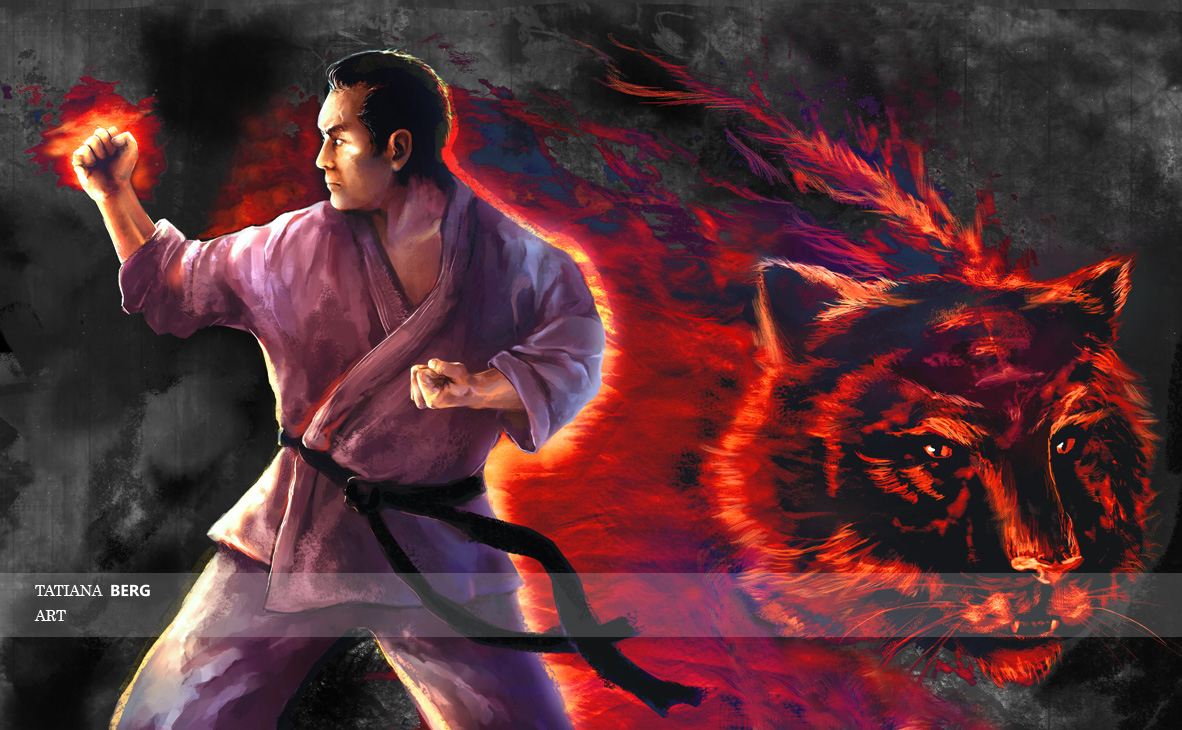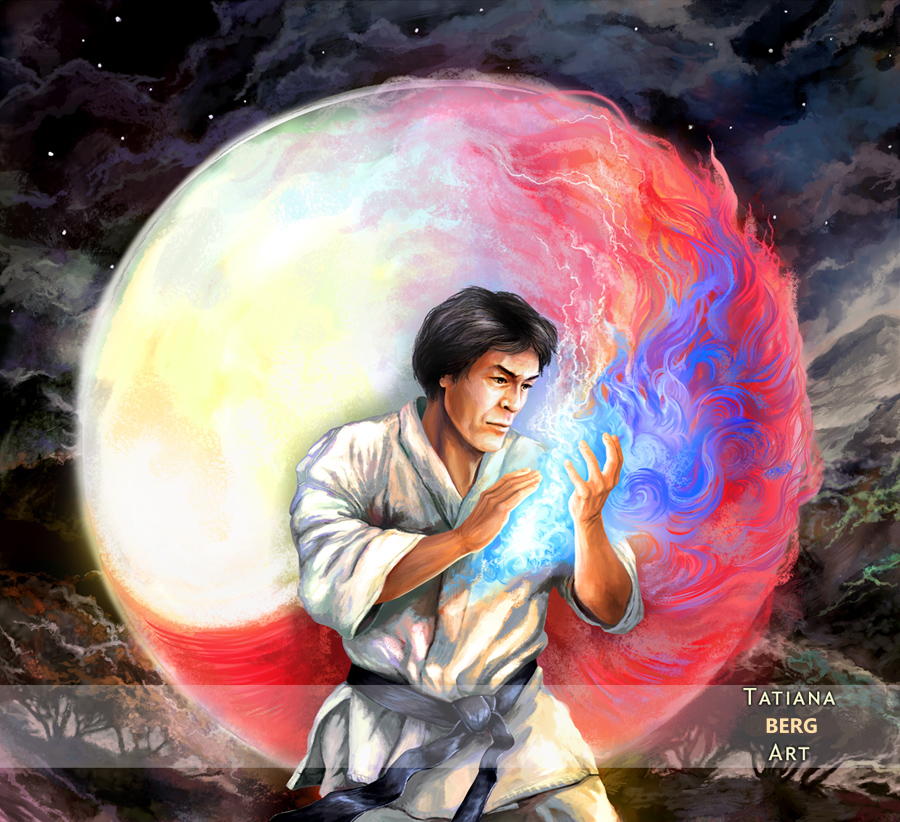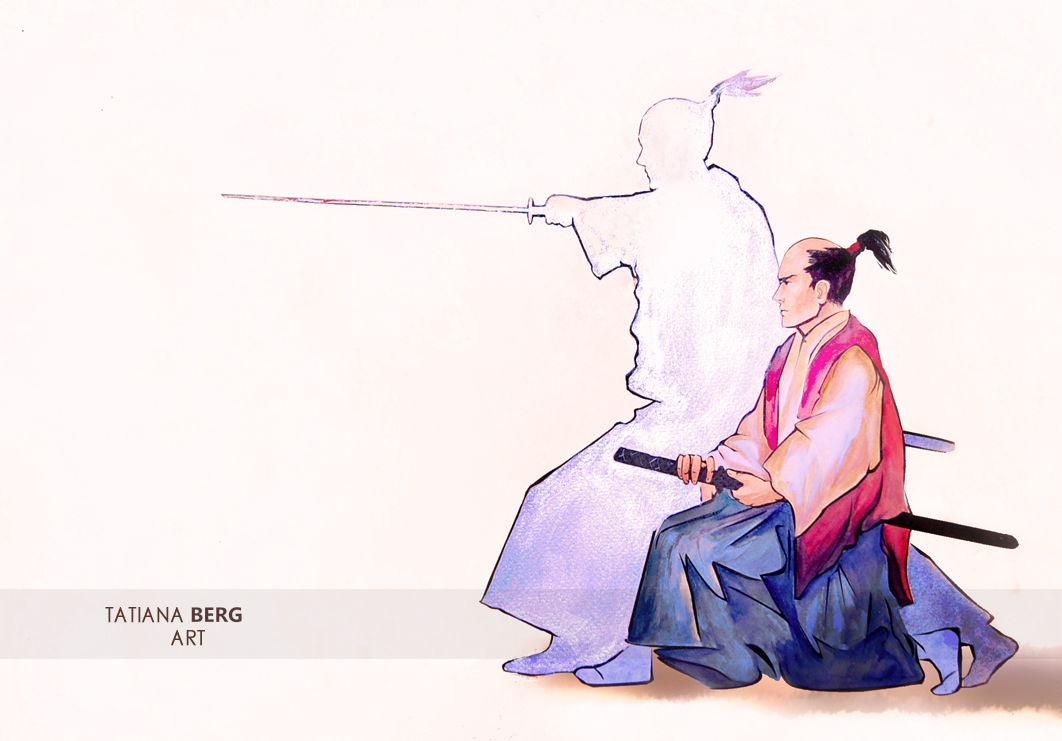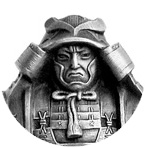Famous martial arts masters
Aikido, karate & iaido
-
Morihei Ueshiba (植芝盛平)

Ueshiba Morihei art by Tatiana Berg | Purchase print or painting | All ArtworkThere are no contests in the Art of Peace. A true warrior is invincible because he or she contests with nothing. Defeat means to defeat the mind of contention that we harbor within.
—Morihei UeshibaMorihei Ueshiba (1883–1969) is one of the legendary figures of Japan who founded the Japanese martial art of Aikido (合気道). He is often called Ōsensei which literally means “The Great Teacher.” A famous martial artist instructor, he spent much of life gaining and imparting knowledge of the fine art. Interestingly, Ueshiba was once a frail child who was weak and feeble. However, he soon changed himself by getting into the military. Relieved from his duties, he moved to Hokkaido where he joined hands with Takeda Sōkaku, the founder of Daitō-ryū Aiki-jūjutsu. Later on, he joined Ōmoto-kyō movement in Ayabe, serving as a martial arts instructor and opening his first dojo. Though he was known for his skills and art, it was after the spiritual enlightenment in the 1925 that his skills were supremely enhanced. His later spiritual experiences in 1940 and 1941 shaped much of what his future teachings comprised of. Interestingly, the more spiritual Ueshiba turned in his outlook, the more changes he brought about in his art which became softer and more circular. He altered the formal curriculum to make it simpler concentrating more on “breath throws”, which used opponent’s movement to defeat them.
Ueshiba’s experience in a changing world, experiencing the brutalities of war, and pursuit of spiritual reconciliation is what set the foundation for the path of Aikido, and what established a vision for Aikido as a path based on martial strength but whose purpose is for unification and not destruction.
“Aikido has no end,” he said before he died. “There’s just the beginning and further growth.” The founder of Aikido may have passed on, but his art continues to thrive around the world.Masutatsu Ōyama (大山倍達)

Masutatsu Oyama art by Tatiana Berg | Purchase print or painting | All ArtworkA human life gains lustre and strength only when it is polished and tempered.
— Mas ŌyamaSosai Masutatsu Ōyama (1923–1994), the founder of Kyokushin Karate (極真会), commonly known as Mas Ōyama, was born into an aristocratic family in a small village in South Korea in 1923. His birthname was Choi Yeong-eui, but when he emigrated to Japan, he was pressured into taking a Japanese name. He chose Ōyama, meaning “The Great Mountain,” in honor of the family that befriended and took him in while in Japan.
Kyokushin style presents to his supporters demanding, mastering them requires a serious athletic training and strict discipline. However, despite the cruelty and maximalism, even demands the cultivation of style around the world carried out taking into account the diverse interests of fans of martial arts in the spirit of the democratic ideal “Karate for millions.” Some are attracted to the Kyokushin system of breathing exercises, the other – the methods of physical training, the third – the system of psycho-regulation, the fourth – self-defense, the fifth – the opportunity to engage in manly sport.
Because the path to the truth in martial arts is a reality only through the struggle, at the eastern views, it becomes the active form of meditation leading to enlightenment.
Mas Ōyama did not only create an extremely effective martial art but he also gave us the Kyokushin way of life philosophy. He was one of the best karate master of all times and he made many great instructors who helped to spread his organization all over the world.Steel is made by fire and thousands of blows. This is the only way to forge a sword. A warrior must be prepared for great pain to acquire mastership. Martial arts are a method of spiritual self-improvement; so continue, even when it seems impossible.
There are no limits to improvement!
Hone your technique. Replay it in your mind thousands of times. Gradually you will cease thinking and begin understanding. Then it will enter your unconscious and become truly yours.
Masutatsu Oyama said: “One becomes a beginner after 1000 days of training. One becomes a master after 10000 days of practice . . . Always remember: In the Martial Arts the rewards of a confident and grateful heart are truly abundant.”
—A. R. Berg, Spirit of the WarriorJōkō Ninomiya (二宮城光)

Joko Ninomiya art by Tatiana Berg | Purchase print or painting | All ArtworkSuccess is a matter of setting one goal at a time and gradually progressing by raising the bar. Plans will never come true by talking or thinking about them without making effort and taking action. Do a little each day and you will reach your goal.
—Jōkō NinomiyaKancho Joko Ninomiya (born January 27, 1954) is an outstanding karate master and founder of the Enshin style. A student of Hideyuki Ashihara, Joko Ninomiya first began training in Kyokushin; he finished third in the first All-World Tournament (1975) and won the All-Japan championship (1978), but later started his own style – Enshin Karate-do, popular all over the world, and in Russia as well.
The name "Enshin" consists of two Japanese characters: “en,” or “unfinished circle,” and “shin,” or “heart.” It is known that sabaki (body repositioning), a type of circular body movement to get into the blind spot of your opponent to use their power and momentum against them, is a method actively employed in Enshin, but the name of the style also implies constant self-improvement that has no end like an unfinished circle, putting your heart into your training and being spiritually united with everybody following the same Way.Ignorance can be overcome if you study conscientiously. Until you dispel your innate folly, you will never become wise. By consistently polishing your skills, you will comprehend the wisdom of your art and folly will be replaced with wisdom.
Training your body is not enough. Change your consciousness!
—A. R. Berg, Spirit of the WarriorHayashizaki Shigenobu (林崎甚助源の重信)

Iaido art by Tatiana Berg | Purchase print or painting | All ArtworkIai is training the soul with a sword. Free your sword, not just unsheath it — it is the way to victory!
Tamijimaru (1542–1621) was brought up in the Hayashizaki Kumano Jinja shrine absorbing ancestral traditions and learning the art of the Sword. In his prayers he asked the Gods to make him grow fast like a young bamboo so he could avenge his father’s death. The days lingered heavily, but time ceased to exist when he took a sword into his hands.
Years passed while he trained and prayed. After acquiring his new name, Hayashizaki Jinsuke Minamoto-no Shigenobu, in his coming-of-age rite, the eighteen-year-old embarked on fulfilling his Revenge Duty. After two years of searching he found the right man training in the woods, alone. Hayashizaki gazed at his father’s murderer in a trance. He was blown away by his brilliant swordsmanship. He had never seen a high-level master!
The young samurai’s heart sank with an unbearable sadness; he knew he had no chance of winning against such an experienced rival. Hayashizaki had spent many days stealthily watching his opponent as he practiced, trying to find the slightest imperfection, to no avail. Years of training and research did not help. What could he feel in this situation? Only desolation and hopelessness.
He decided to leave this world at dawn. At death’s door, however, the thoughts vanished and Divine revelation descended on him, enlightening him about a new method to draw a sword and slash in a single movement.
A Warrior does not revenge, he restores righteousness.
The liberated mind revealed a different meaning of life, a different take on the Art of the Sword: “I entrust sword liberation with my life.”
Hayashizaki was mastering with abandon the method revealed to him and after several months he felt his moment had come.
He found his enemy. When the man approached, Hayashizaki introduced himself in compliance with samurai custom and openly declared his intention. Judging by the young age of his opponent, Sakagami Shuzen could not infer that everything was already determined. He barely had time to put his hand on the sword hilt when Hayashizaki ended his life with a lighting-quick slash.
The Duty was fulfilled.
That was how the special style of swordsmanship, the “unparalleled godsend style” came into being. Hayashizaki’s fame spread like wildfire in feudal Japan. The single slash – victory as a Gift, the Divine Revelation, quicker than the blink of an eye, the only one invisible to the rival – had become an extremely dangerous method of single combat, the fundamental part of samurai ethics.
Therefore, due to its sacral appearance and efficiency, the new method of instantaneous sword liberation quickly gained followers.When revenge is inevitable, theenemy’s blood is more sacred than thetears of thousands of Buddhas. A katanawill slash you or the enemy, inscribingwith blood the most importantcharacter in a samurai’s life, Honor.
***
The first to be taught Hayashizaki’sstyle were the elite samurai and nobles,mainly because they were the most frequent participants in duels and themain targets of assassins. Moreover, theyhad the time and means that it required.Essentially, they were daimyo, and lateron the shogun as well as his retinues andbody-guards were also trained. This stylehad become the elite martial art andeven more, the ‘slash-lightning’ becamea sign of the highest skill and power ofthe noble Warriors.
—A. R. Berg, Samurai: AscensionBack to the Blog

